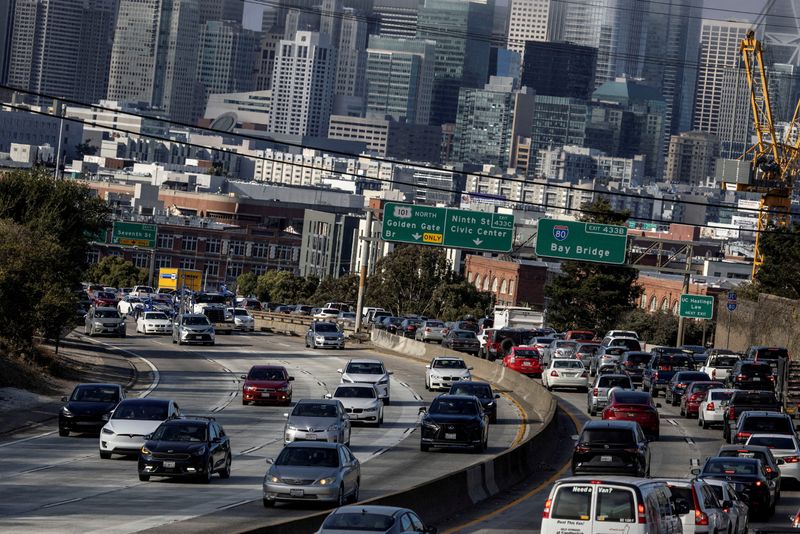By Timothy Aeppel
(Reuters) – A new form of sticker shock has hit American car buyers like Darin Davis.
When the 56-year-old Dallas real estate agent renewed the insurance in January on the pearl white 2024 Cadillac XT4 he bought just months earlier, the rate nearly doubled.
“It’s no longer fun to own a new car when you’re paying that much money,” Davis said, adding that he might have opted for a cheaper model if he had known such a massive increase was coming. But by then it was too late.
In one of the cruel twists of an inflation-weary U.S. economy, car prices are falling after rising by records during the COVID-19 pandemic. However, at least some of these consumer benefits are being offset by rising auto insurance rates, which now account for more than a quarter of the total cost of owning a vehicle for some models.
Car prices have fallen as pandemic supply chain problems – particularly shortages of vital computer chips – have eased and automakers increase inventory on their lots. Meanwhile, factors such as rising costs associated with repairing increasingly complex vehicles and more storm damage due to climate change are driving up insurance premiums.
And car buyers aren’t the only ones dealing with insurance inflation. For Federal Reserve policymakers committed to lowering overall inflation, this is an example of the unwelcome surprises that have slowed their progress.
HARMS AFFORDABILITY
According to the Labor Department, the consumer price index rose 3.5% last month compared to a year earlier. But car insurance costs rose 22.2% over the same period, the sharpest increase since the 1970s.
Meanwhile, car prices remained moderate. New car prices fell 0.1% year-on-year, while used car prices fell 2.2%. Car dealers offer more incentives to buyers, which helps reduce upfront costs. It’s unclear to what extent insurance premiums influence purchasing decisions, but there are signs that they have become a larger factor, particularly for consumers on tight budgets.
“We hear from a number of buyers that they are declining to buy a car — or returning one — because they can afford the car but not the insurance on it,” said Sean Tucker, senior editor at Kelley Blue Book, an auto review company – and research company in Irvine, California.
Tucker said Kelley Blue Book recently added insurance advice to its list of buying tips and encouraged customers to get an insurance quote before investing money.
Car insurance rates vary widely across the country and are influenced by many factors, from the cost charged by local collision repair shops to potential damage from tropical storms and wildfires. According to insurance shopping website Insurify, the average cost of comprehensive insurance in the U.S. has risen 24% over the past year and is now just over $182 per month. The company said 63% of motorists it surveyed saw rates increase in 2023 and predicts rates will rise another 7% in 2024. However, this number could increase.
“We’re seeing a lot of activity in the (first quarter) that suggests it could increase even further,” said Jessica Edmondson, data specialist at Insurify.
TOTAL COST
Insurance’s share of the so-called total cost of owning a vehicle, which takes into account things like routine maintenance, taxes, depreciation and fuel, and insurance, appears to be continuing to grow. According to Kelley Blue Book, insurance on a compact car averaged 16% of that value in 2019 and will rise to 26% in 2024. For a compact SUV, it was 13% in 2019, but this year it will be 20%.
Several forces have joined forces to drive the current rise in interest rates. There are more total losses than in the past, and during the production disruptions caused by the pandemic, quality issues that can lead to insurance claims are increasing. A shortage of mechanics has caused a car to take longer to repair, which in turn drives up costs for insurance companies that provide rental cars to policyholders waiting for repairs. A typical car is also increasingly equipped with electronics that can make it more expensive and difficult to repair.
“A bumper is just a bumper — but repairing a bumper full of sensors costs more,” said Kristin Dziczek, a policy adviser at the Federal Reserve Bank of Chicago and an expert on automotive industry trends. She noted that electric cars cost, on average, 30% more and can take longer to repair.
There are also changes in the way automakers produce cars that have insurance implications. Tesla, for example, has developed a process called gigacasting, which involves casting a single part that can replace 30 or more separate metal parts in a traditional vehicle. This reduces production costs, but can make repairing a vehicle in an accident more expensive.
Other car manufacturers are following suit. Cadillac now makes a model that uses 16 Gigacastings.
Meanwhile, Davis — the Dallas real estate agent who bought a new Cadillac — said he finally found a cheaper option by bundling his auto and home insurance and increasing the deductible.
(Reporting by Timothy Aeppel; Editing by Dan Burns and Anna Driver)
